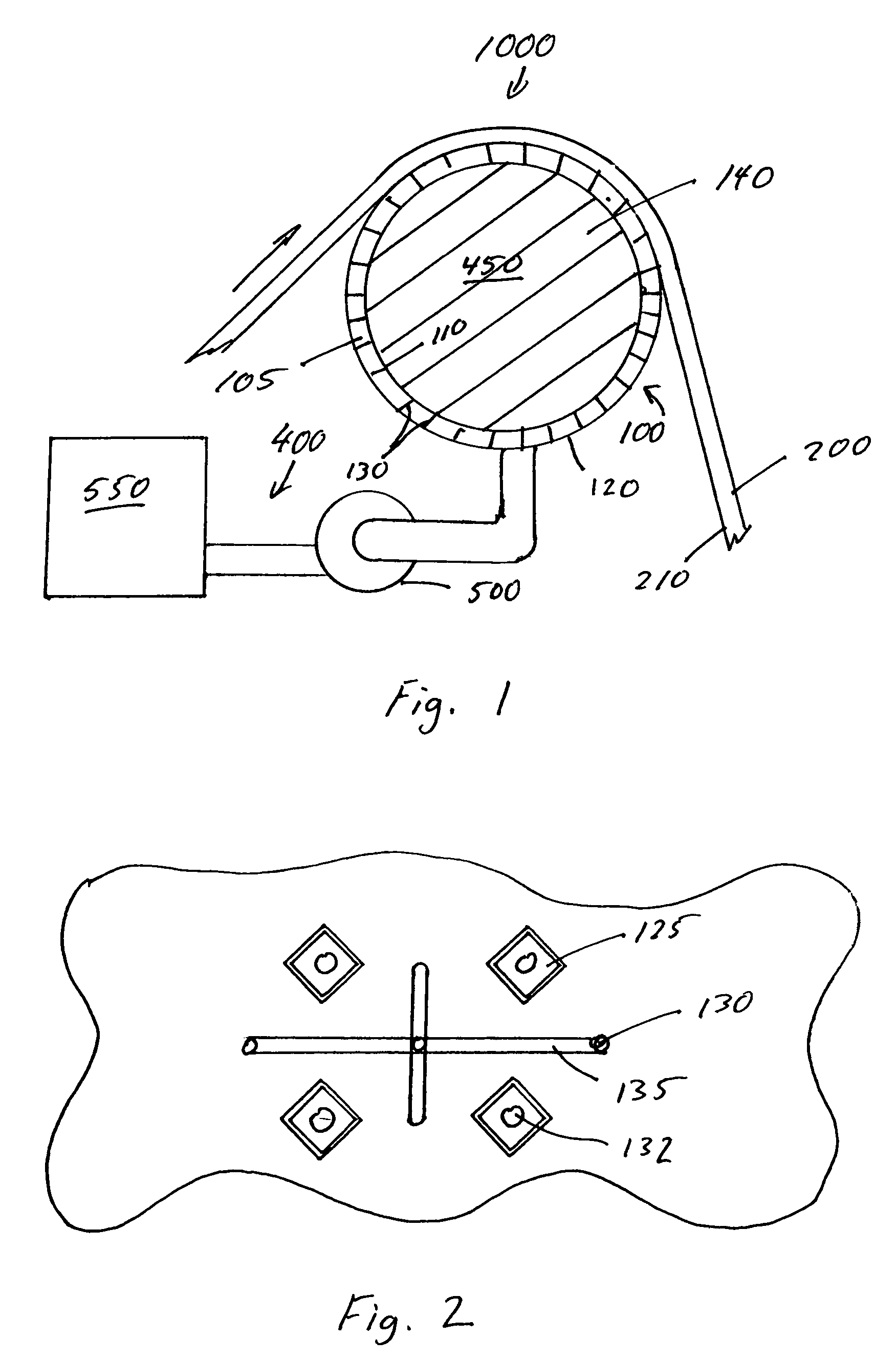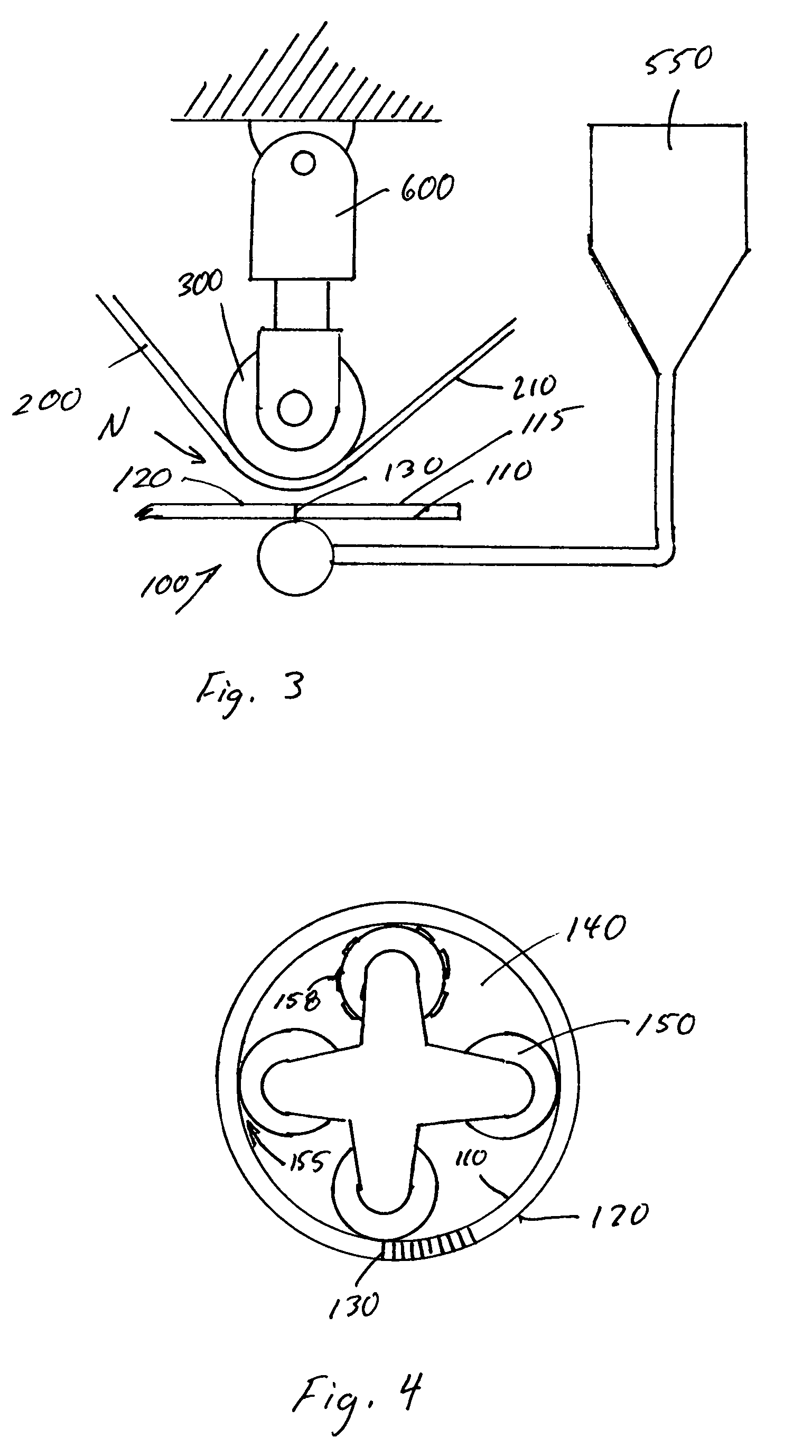Apparatus and method for the transfer of a fluid to a moving web material
a technology of fluid transfer and web material, applied in the direction of thin material processing, rotary lithographic machines, coatings, etc., can solve the problems of limited fluid placement, application rate, or fluid dose, and limit the fluid types, etc., to facilitate the transfer of fluid
- Summary
- Abstract
- Description
- Claims
- Application Information
AI Technical Summary
Benefits of technology
Problems solved by technology
Method used
Image
Examples
example 1
[0057]In a paper-converting process, a steel cylinder having a shell thickness of about 0.125 inches (about 3 mm) and a width of about 6 inches (about 15 cm) is rotatably supported along an axis. A rotary union connects the interior of the shell to a fluid supply pump. The shell comprises an array of pores 130 arranged in a uniform pattern about the outer surface of the shell. The pores each have a diameter of about 0.002 inches (0.15 mm). A paper softening agent is pumped into the interior of the shell through the rotary union. The pump provides sufficient fluid pressure to motivate the agent through the pores forming droplets upon the outer surface of the shell.
[0058]A paper web is routed through the converting apparatus and into contact with the fluid droplets upon the outer surface of the shell. The fluid droplets transfer from the outer surface to the web material providing an array of deposits of the agent upon the web corresponding to the array of pores. The spacing and arran...
example 2
[0059]In a paper converting process a log of a paper web is wound from a continuous web supply. The log is wound about a cardboard core. As a desired web quantity for each log is achieved the web of the log is separated from the continuous supply of the web. The trailing edge of the log is not attached to the log at this point and is considered a web tail. The log proceeds through the converting apparatus to a log tail sealer.
[0060]The tail sealer is adapted to attach the web tail to the remainder of the log. The tail sealer comprises a flat plate over which the log is constrained to roll. The plate comprises an array of pores extending across the plate and transverse to the direction of travel of the log. The pores are connected to a cylindrical fluid reservoir disposed beneath the flat plate. The fluid reservoir is operably connected to a fluid supply. An internal roller rotates in contact with the internal surface of the reservoir. The rotation of the internal roller is sequenced...
example 3
[0063]In a web printing operation a series of five print cylinders are arrayed at respective points around the circumference of a web support cylinder. Each of the print cylinders comprises a thin shell and an array of pores specifically situated to provide an array of dots of ink that may subsequently be transferred to a web material passing between the print cylinder and the support cylinder. The pore array of each cylinder may be distinct from the array of the other print cylinders. The particular pore array of each cylinder may be related to the particular ink color to be applied by each cylinder. The combination of the five pore arrays in the proper spatial relationship may yield a multi-color composite image. The pores may also be of varying size in order to incorporate Amplitude Modulation screening or other aesthetic effects.
[0064]A series of five inks may be successively applied to a white web material as the web material passes between the print cylinders and the support c...
PUM
 Login to View More
Login to View More Abstract
Description
Claims
Application Information
 Login to View More
Login to View More - R&D
- Intellectual Property
- Life Sciences
- Materials
- Tech Scout
- Unparalleled Data Quality
- Higher Quality Content
- 60% Fewer Hallucinations
Browse by: Latest US Patents, China's latest patents, Technical Efficacy Thesaurus, Application Domain, Technology Topic, Popular Technical Reports.
© 2025 PatSnap. All rights reserved.Legal|Privacy policy|Modern Slavery Act Transparency Statement|Sitemap|About US| Contact US: help@patsnap.com



